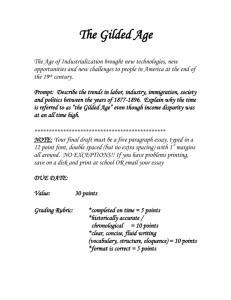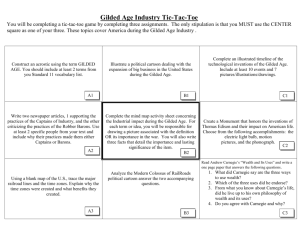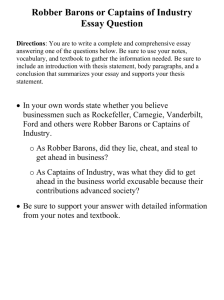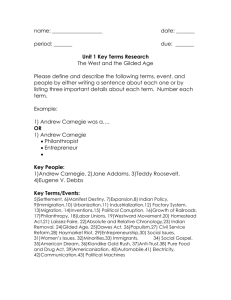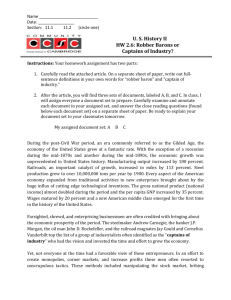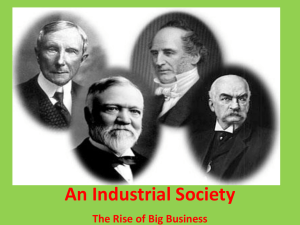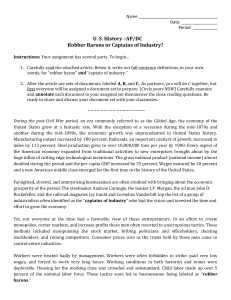Captains of Industry
advertisement
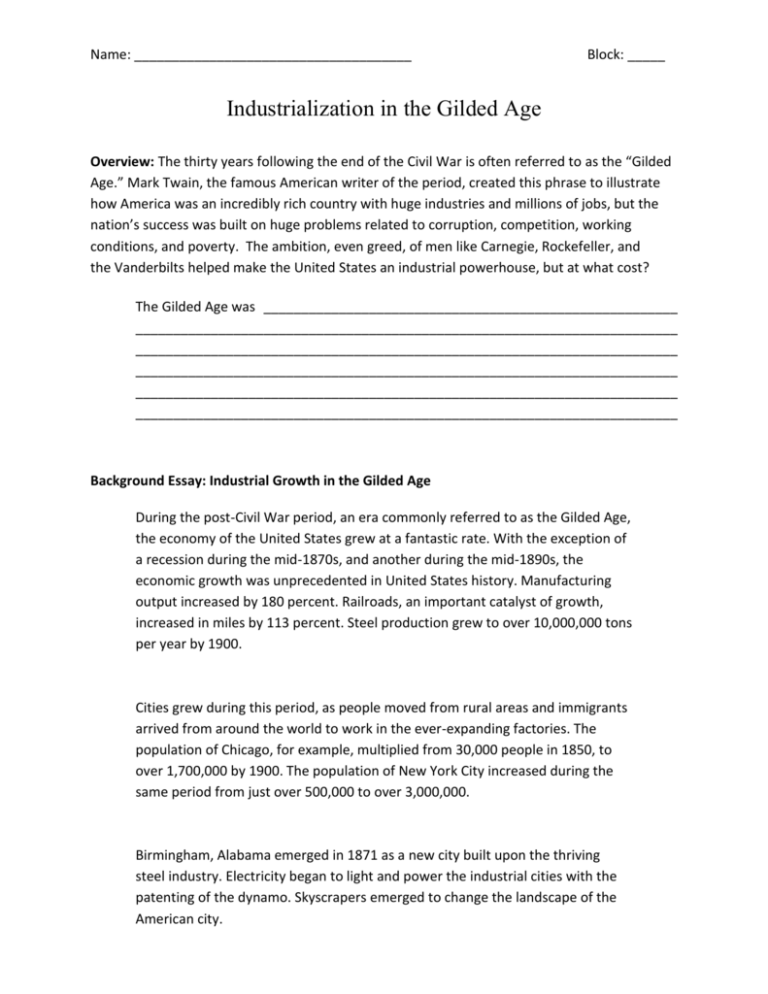
Name: _____________________________________ Block: _____ Industrialization in the Gilded Age Overview: The thirty years following the end of the Civil War is often referred to as the “Gilded Age.” Mark Twain, the famous American writer of the period, created this phrase to illustrate how America was an incredibly rich country with huge industries and millions of jobs, but the nation’s success was built on huge problems related to corruption, competition, working conditions, and poverty. The ambition, even greed, of men like Carnegie, Rockefeller, and the Vanderbilts helped make the United States an industrial powerhouse, but at what cost? The Gilded Age was _______________________________________________________ ________________________________________________________________________ ________________________________________________________________________ ________________________________________________________________________ ________________________________________________________________________ ________________________________________________________________________ Background Essay: Industrial Growth in the Gilded Age During the post-Civil War period, an era commonly referred to as the Gilded Age, the economy of the United States grew at a fantastic rate. With the exception of a recession during the mid-1870s, and another during the mid-1890s, the economic growth was unprecedented in United States history. Manufacturing output increased by 180 percent. Railroads, an important catalyst of growth, increased in miles by 113 percent. Steel production grew to over 10,000,000 tons per year by 1900. Cities grew during this period, as people moved from rural areas and immigrants arrived from around the world to work in the ever-expanding factories. The population of Chicago, for example, multiplied from 30,000 people in 1850, to over 1,700,000 by 1900. The population of New York City increased during the same period from just over 500,000 to over 3,000,000. Birmingham, Alabama emerged in 1871 as a new city built upon the thriving steel industry. Electricity began to light and power the industrial cities with the patenting of the dynamo. Skyscrapers emerged to change the landscape of the American city. Farsighted, shrewd, and enterprising businessmen are often credited with bringing about the economic prosperity of the period. The steelmaker Anderw Carnegie, the banker J. P. Morgan, the oilman John D. Rockefeller, and the railroad magnates Jay Gould and Cornelieus Vanderbilt top the list of a group of industrialists often identified as the “captains of industry” who had the vision and invested the time and effort to grow the economy. Not everyone at the time had a favorable view of these entrepreneurs. In an effort to create monopolies, corner markets, and increase profits, these men often resorted to rather unscrupulous tactics. These methods included manipulating the stock market, bribing politicians and officeholders, and ruining competitors. Consumer prices rose as the trusts held by these men came to control entire industries. Workers were treated badly by the capitalists and their management organizations. Workers were often forbidden to strike, paid very low wages, and forced to work very long hours. Working conditions in both factories and mines were deplorable. Housing for the working class was crowded and substandard. Child labor made up over five percent of the national labor force. These tactics soon led to the businessmen being labeled as “robber barons.” By the early twentieth century, the richest nine percent of Americans controlled 75 percent of the national wealth. The number of millionaires increased from 390 to over 4,000. Yet, working families were forced to rely on two, three, and sometimes four incomes just to make ends meet. To the poor, the working class, the reformers, and the consumers, the Gilded Age was not so golden. Still, the businessmen of the period felt justified in their actions, as the United States became the world’s leading industrial power, with the U.S. producing as much as Germany, Great Britain, and France combined. Examine the documents that follow and determine for yourself if these men were Captains of Industry, or Robber Barons. Name: _____________________________________ Block: _____ Background Essay Questions 1. According to the background essay, how did the economy of the United States grow during the Gilded Age? Be sure to support your answer with a “snippet” from the text and an explanation. _____________________________________________________________________________ _____________________________________________________________________________ _____________________________________________________________________________ _____________________________________________________________________________ _____________________________________________________________________________ _____________________________________________________________________________ _____________________________________________________________________________ _____________________________________________________________________________ 2. According to the background essay, what were some of the methods used by businessmen to create monopolies and increase profits? Be sure to support your answer with a “snippet” from the text and an explanation. ______________________________________________________ _____________________________________________________________________________ _____________________________________________________________________________ _____________________________________________________________________________ _____________________________________________________________________________ _____________________________________________________________________________ _____________________________________________________________________________ _____________________________________________________________________________ _____________________________________________________________________________ 3. According to the background essay, how were workers treated during the Gilded Age? Be sure to support your answer with a “snippet” from the text and an explanation. _________________ _____________________________________________________________________________ _____________________________________________________________________________ _____________________________________________________________________________ _____________________________________________________________________________ _____________________________________________________________________________ _____________________________________________________________________________ _____________________________________________________________________________ _____________________________________________________________________________ _____________________________________________________________________________ Captains of Industry or Robber Barons Activity Directions: Examine the two definitions below. Then, read the list of business activities practiced by or related to businessmen of the Gilded Age. In the box next to each, write C.I. if the activity describes a practice of a Captain of Industry or R.B. if the activity describes a practice of a Robber Baron. Captain of Industry – a term originally used to describe a business leader whose means of amassing a personal fortune contributed positively to the country in some way. This may have been through increased productivity, expansion of markets, providing more jobs, or acts of philanthropy. Robber Baron – a disparaging term used to describe a powerful 19th century businessman or banker who used questionable or unethical business practices to become powerful or wealthy. 1. After his retirement, Andrew Carnegie donated most of his money (over $350 million) to establish libraries, schools, and universities, as well as a pension fund for former employees. 2. In 1901, J. P. Morgan’s U.S. Steel was the first billion-dollar company in the world with an authorized capitalization of $1.2 billion. The size and productivity of U.S. Steel allowed the U.S. to compete globally against countries such as Britain and Germany. 3. In response to a strike at Andrew Carnegie’s Homestead, Pennsylvania steel plant in 1892, Carnegie hired Pinkerton detectives to protect strikebreakers brought in to work in the place of striking workers. Ten men were killed and hundreds injured in an attempt to break the strike. 4. In 1895, at the depths of the Panic of 1893, J.P. Morgan loaned the U.S. Treasury $65 million in gold, to safeguard the collapse of the U.S. government. 5. Cornelius Vanderbilt continuously cut shipping rates to the point that other steamboat and railroad companies could not compete and were forced out of business. 6. The entrepreneur James J. Hill often donated seed, grain and cattle to farmers who had been affected by drought and depression. 7. John D. Rockefeller often resorted to using spies and extortion to influence railroads to work in his favor by offering him kickbacks and rebates that were denied to his competitors. 8. By 1890, the richest nine percent of Americans held 75 percent of the nation’s wealth. The average yearly income for a worker was $380. Andrew Carnegie had a yearly income of $25 million by 1900.
